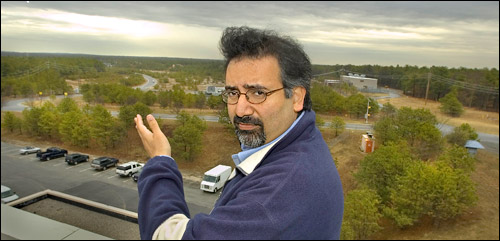eRHIC Gets to the Heart of the Matter
April 23, 2006
DALLAS, TX - At the U.S. Department of Energy's Brookhaven National Laboratory, scientists have proposed a new way of studying the structure of matter down to a level never before observed. Their proposal is the "eRHIC" collider, a planned upgrade to Brookhaven's giant particle accelerator, the Relativistic Heavy Ion Collider (RHIC).
"The eRHIC facility will give physicists the ability to make some very important and unique particle and nuclear-physics measurements," said Abhay Deshpande, a physicist at Stony Brook University and the RIKEN BNL Research Center, who is part of the eRHIC team. "It promises significant leaps in physicists' understanding of the structure of nucleons (protons and neutrons) and of nuclei, which make up more than 99 percent of the matter around us."
 enlarge
enlarge
Physicist Abhay Deshpande overlooking the Relativistic Heavy Ion Collider. (Click image to download hi-res version.)
Deshpande will discuss the design of the eRHIC detector at the 2006 American Physical Society national meeting in Dallas, Texas. His talks will take place on Sunday, April 23, 2006, at 1:30 p.m. in Room Landmark B of the Hyatt Regency Dallas.
The eRHIC facility will be built alongside the existing RHIC ring. It will produce a beam of electrons (hence the "e" in eRHIC) that will move at nearly the speed of light. RHIC and eRHIC will overlap at one point, allowing the RHIC ions and the eRHIC electrons to collide. This collision will create an explosion of particles that will then be extensively studied using a large detector built around the collision point. In essence, the electrons will be used to probe the matter contained within the ions, with very high precision.
Analyzing these collisions will help scientists answer fundamental questions in physics, such as how quarks and gluons combine to create protons, what role the gluons play in the formation of nuclei at very high energies, and why scientists have yet to observe free quarks (those not bound within protons or neutrons).
Another longstanding problem, which involves a property called "spin," will be addressed with extreme precision. The laws of quantum mechanics state that the spins of quarks and gluons should add up, such that the spin of a proton should equal the sum of the spins of the quarks and gluons that comprise it. However, according to experimental data, this doesn't happen. The sum of the spin of the quarks only accounts for about 30 percent of the proton's spin.
If eRHIC turns on according to current plans, which could make the facility operational as early as 2015, Deshpande and his colleagues hope to shed light on this and other basic questions that physicists still have no answers for. Addressing these problems will lead to new insights into the nature of matter itself.
RHIC is funded primarily by the Office of Nuclear Physics within the U.S. Department of Energy's Office of Science.
2006-10478 | INT/EXT | Newsroom









